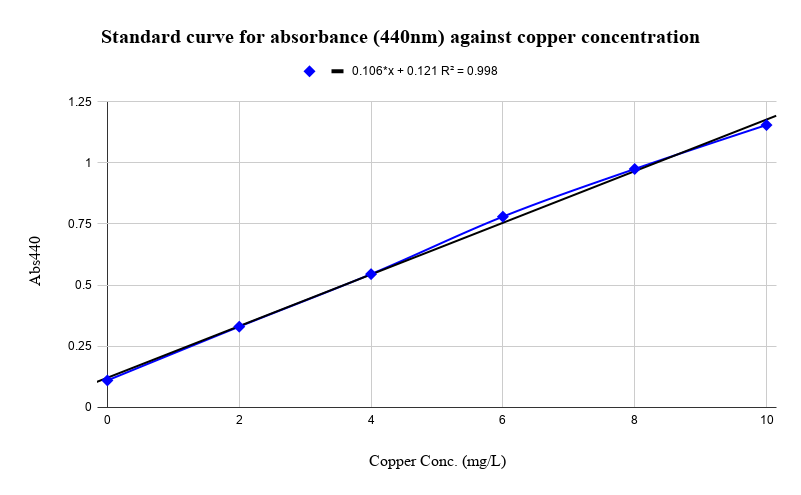Difference between revisions of "Part:BBa K3076803"
| Line 26: | Line 26: | ||
[[File:CgMT result.png|400px|thumb|center|The <i>CgMT</i>-expressing group removed ~30% of copper ions in the medium when compared with controls removing only ~12 - 15%.]] | [[File:CgMT result.png|400px|thumb|center|The <i>CgMT</i>-expressing group removed ~30% of copper ions in the medium when compared with controls removing only ~12 - 15%.]] | ||
| + | |||
| + | ===References=== | ||
| + | [1] Jafarian, V., & Ghaffari, F. (2017). A unique metallothionein-engineered in Escherichia coli for biosorption of lead, zinc, and cadmium; absorption or adsorption? Microbiology, 86(1), 73–81. doi: 10.1134/s0026261717010064 | ||
Revision as of 04:52, 13 October 2019
Expression of CgMT driven by T7 promoter under LacO regulation
Description
This composite part was used to express the Corynebacterium glutamicum metallothionein gene (CgMT) in BL21(DE) E. coli strain. The expression of CgMT showed an increase in the copper absorption ability in E. coli which suits our purpose of creating a bacterial absorbent of metal pollutants in the liquid medium.
The CgMT coding sequence (BBa K3076100) was tagged with 6xHis tag and expressed under the regulation of the strong T7 promoter (BBa I719005), a lac operator (BBa K3076802) and a strong RBS (BBa K3076801). The terminator is T7 terminator (BBa K395601).
Usage and Biology
Metallothioneins (MT) are proteins made of 61-68 amino acids with a small molecular weight. It is found in almost every known organism, from bacteria to humans. Due to this ubiquity, it minimizes the gene toxicity effect when we choose it as the ectopic expression target.
MT contains many cysteine groups which were reported to be responsible for chelating a wide range of metal ions such as cadmium, lead, copper, and mercury, etc. Nevertheless, MT from different species showed different affinity towards different metal ions.
Literature reported that MT protein from Corynebacterium glutamicum (CgMT) shows strong binding affinity towards divalent cations, such as Zn2+ and Pb2+. [1] Since our project used Cu2+ as a model for the metal pollutants, we decided to explore the plausibility of using CgMT to increase the metal accumulation ability of E. coli.
Copper removal assay
The E. coli expressing CgMT was put into copper (II) sulphate-containing medium. The concentration of copper ions in the medium was measured at different time points. API copper testing reagent was used in this assay. The reagent reacts with copper ions and forms brown colour precipitate. We used a colourimeter to measure the absorbance (440nm) of the reagent mixture and calculate the concentration of copper ion by a standard curve.

We found that when compared with no IPTG induction control group and empty vector control group, the CgMT gene -expressing group removed significantly more copper ions inside the medium after 4 hours of incubation. This result indicates CgMT gene expression can effectively increase the copper absorption ability of E. coli and it serves the aim of our project which we tried to increase the metal pollutant removal ability of E. coli.
References
[1] Jafarian, V., & Ghaffari, F. (2017). A unique metallothionein-engineered in Escherichia coli for biosorption of lead, zinc, and cadmium; absorption or adsorption? Microbiology, 86(1), 73–81. doi: 10.1134/s0026261717010064
Sequence and Features
- 10INCOMPATIBLE WITH RFC[10]Illegal XbaI site found at 47
Illegal PstI site found at 356 - 12INCOMPATIBLE WITH RFC[12]Illegal PstI site found at 356
- 21COMPATIBLE WITH RFC[21]
- 23INCOMPATIBLE WITH RFC[23]Illegal XbaI site found at 47
Illegal PstI site found at 356 - 25INCOMPATIBLE WITH RFC[25]Illegal XbaI site found at 47
Illegal PstI site found at 356 - 1000INCOMPATIBLE WITH RFC[1000]Illegal BsaI site found at 137

